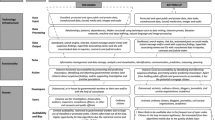Abstract
This paper tackles the quite difficult topic of money laundering. After defining money laundering, and after explaining the three stages (steps), placement, layering and integration, the paper tries a quantification and estimation of the volume and development of money laundering activities. Besides it shows national and international measurements to fight money laundering and various effects on macroeconomics. The overall turnover in organized crime for example had a value of 800 billion USD in 2001 and increased to 1.700 billion USD in 2007. These figures are very preliminary with a quite large error, but give a clear indication how important money laundering and the turnover of organized crime is nowadays.



Similar content being viewed by others
Notes
Own calculations.
Compare Vanempten and Verduyn 1994, p. 24f. Hereunto the FIU Germany: “Cash transactions continue to play a significant role in a large number of cases. Evidently, offenders are aware and continue to deliberately exploit the advantage of “interruption of the paper trail” afforded by cash transactions. Particularly significant in this context are the very large amounts involved in some of these cash transactions.” BKA 2005, Annual Report 2004 Financial Intelligence Unit (FIU), p. 42.
Compare BMI 2005.
Compare BKA 2007a, Kurzfassung des Lagebildes Organisierte Kriminalität 2006 Bundesrepublik Deutschland, p. 5.
Compare Siska 1999 and own calculations.
Schneider 2000, p. 3.
Compare Vanempten and Verduyn 1994, p. 24f.
Compare Bongard 2001, p. 55 and p. 181.
UNDOC 2008, p. 9.
UNDOC 2005, p. 5 and p. 127.
Compare Siska 1999, p. 28.
Compare Ertl 2002, p. 8.
English translation of Germany’s penal code. See https://www.imolin.org/amlid/showLaw.do?law=6301&language=ENG&country=GER.
English translation of Austrian’s penal code of 1993. See https://www.imolin.org/amlid/showLaw.do?law=5951&language=ENG&country=AUS.
Compare IMF 2002.
Riegler 2004, p. 41.
Compare Riegler 2004, p. 65ff.
There is no standard of typology so far.
ARS = Any system used for transferring money from one location to another and generally operating outside the banking channels. The services encompassed by this broad definition of ARS range from those managed by large multinational companies to small local networks. They can be of a legal or illegal nature and make use of a variety of methods and tools to transfer the money (FATF/GAFI 2005, p. 3).
Compare BKA 2005, Annual Report 2004 Financial Intelligence Unit (FIU), p. 47.
Compare BKA 2005, Annual Report 2004 Financial Intelligence Unit (FIU), p. 22ff.
Compare Altenkirch 2002, p. 63ff.
See Banerjee, Money Laundering in the EU, http://www.ex.ac.uk/~watupman/undergrad/ron/explosion%20of%20money%20laundering.htm.
Compare Couvrat and Pless 1993.
Compare IMF 1996.
See Handelsblatt 2005, Anti-Geldwäsche-Kampf behindert Geldverkehr, http://www.handelsblatt.com/pshb/fn/relhbi/sfn/buildhbi/cn/GoArt!204867,204886,981478/index.html.
See Stern 2004, Das Geschäft mit dem schmutzigen Geld, http://www.stern.de/wirtschaft/geldanlage/531574.html?nv=ct_mt.
References
Altenkirch, L. (2002). Techniken der Geldwäsche und ihre Bekämpfung, Frankfurt/Main 2002.
Altvater, E. (2002). Schattenseiten der Globalisierung, verfügbar unter: http://www.polwiss.fu-berlin.de/people/altvater/B10Schattenglob.pdf.
Arbeitsgruppe Identitätsschutz im Internet. (2005). Immer mehr Schaeden durch phishing, verfügbar unter: https://www.a-i3.org/content/view/317/28/. Accessed 6 October 2008.
Banerjee, R. Money Laundering in the EU, verfügbar unter www.ex.ac.uk/~watupman/undergrad/ron/explosion%20of%20money%20laundering.htm. Accessed 17 September 2008.
BKA. (2005). Annual Report 2004 Financal Intelligence Unit (FIU) Germany, Wiesbaden 2005.
BKA. (2006). Annual Report 2005 Financal Intelligence Unit (FIU) Germany, Wiesbaden 2006.
BKA. (2007a). Kurzfassung des Lagebildes Organisierte Kriminalität 2006 Bundesrepublik Deutschland, 2007.
BKA. (2007b). Annual Report 2006 Financal Intelligence Unit (FIU) Germany, Wiesbaden 2007.
BMI. (2004). Jahresbericht 2003 der Geldwäschemeldestelle (BMin für Inneres, A-FIU), Vienna 2004.
BMI. (2005a). Bericht der Bundesregierung über die Innere Sicherheit in Österreich (Sicherheitsbericht 2004), Vienna 2005.
BMI. (2005b). Jahresbericht 2004 d. Bundesministeriums für Inneres zur Suchtmittelkriminalität, Vienna 2005.
BMI. (2005c). Jahresbericht 2004 der Geldwäschemeldestelle (BMin für Inneres, A-FIU), Vienna 2005.
BMI. (2005d). Geld der Gauner in: Öffentliche Sicherheit, Das Magazin des Innenministeriums, Bundesministerium für Inneres, Nr. 9–10, September–Oktober 2005.
BMI. (2006a). Jahresbericht 2005 d. Bundesministeriums für Inneres zur Suchtmittelkriminalität, Vienna 2006.
BMI. (2006b). Jahresbericht 2005 der Geldwäschemeldestelle (BMin für Inneres, A-FIU), Vienna 2006.
BMI. (2007). Jahresbericht 2006 der Geldwäschemeldestelle (BMin für Inneres, A-FIU), Vienna 2007.
BMI. (2008a). Jahresbericht 2007 d. Bundesministeriums für Inneres zur Suchtmittelkriminalität, Vienna 2008.
BMI. (2008b). Jahresbericht 2007 der Geldwäschemeldestelle (BMin für Inneres, A-FIU), Vienna 2008.
Bongard, K. (2001). Wirtschaftsfaktor Geldwäsche: Analyse und Bekämpfung, Wiesbaden 2001.
Couvrat, J-F., & Pless, N. (1993). Das verborgene Gesicht der Weltwirtschaft, Münster 1993.
Ertl, B. (2002). Working Papers. Der Kampf gegen Geldwäscherei und Terrorismusfinanzierung”, Vienna 2004.
FATF/GAFI. (2005). Money laundering terrorist finance typologies 2004–2005:10.
Handelsblatt. (2005). Anti-Geldwäsche-Kampf behindert Geldverkehr, verfügbar unter: www.handelsblatt.com/pshb/fn/relhbi/sfn/buildhbi/cn/GoArt!204867,204886,981478/index.html. Accessed 29 October 2005.
IMF. (1996). Macroeconomic Implications of Money Laundering, prepared by Quirk, Peter J. International Monetary Fund, Monetary and Exchange Affairs Department. Paper prepared for the Plenary Meeting of the FATF, Washington 1996.
IMF. (1998). Money Laundering: The Importance of International Countermeasures, address by Camdessus, Michel, Plenary Meeting of the Financial Action Task Force on Money Laundering, Paris, February 1998.
IMF. (2002). Caribbean Offshore Financial Centres: Past, Present, and Possibilities for the Future, prepared by Suss, Esther C./Williams, Oral H./Mendis, Chandima. IWF Working Paper, Washington DC. May 2002.
Riegler, W. (2004). Die Quantifizierung der Geldwäsche, Linz 2004.
Schneider, F. (2000). Schattenwirtschaft—Tatbestand, Ursache, Auswirkungen, Beitrag zur Tagung “Die Arbeitswelt im Wandel” vom 4.-6.5.2000 in Mönchengladbach, Linz 2000.
Siska, J. (1999). Die Geldwäscherei und ihre Bekämpfung in Österreich. Wien: Deutschland und der Schweiz. 1999.
Stern. (2004). Das Geschäft mit dem schmutzigen Geld, verfügbar unter: http://www.stern.de/wirtschaft/geldanlage/531574.html?nv=ct_mt. Accessed 27 October 2004.
Tagesspiegel. (2005). Geldwäscher im Visier, verfügbar unter: http://archiv.tagesspiegel.de/archiv/18.11.2005/2180342.asp. Accessed 28 November 2005.
UNDOC. (2005). World Drug Rep 2005:2005.
UNDOC. (2008). World Drug Rep 2007:2008.
Vanempten, J., & Verduyn, L. (1994). Le Blanchiment en Belgique. Bruxelles: L’Argent criminel dans la haute finance. 1994.
Walker, J. (1998). Modelling Global Money Laundering Flows—some findings. Verfügbar unter: http://members.ozemail.com.au/~john.walker/crimetrendsanalysis/mlmethod.htm.
Author information
Authors and Affiliations
Corresponding author
Rights and permissions
About this article
Cite this article
Schneider, F., Windischbauer, U. Money laundering: some facts. Eur J Law Econ 26, 387–404 (2008). https://doi.org/10.1007/s10657-008-9070-x
Published:
Issue Date:
DOI: https://doi.org/10.1007/s10657-008-9070-x




